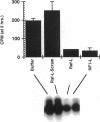Abstract
A key event in Ras-mediated signal transduction and transformation involves Ras interaction with its downstream effector targets. Although substantial evidence has established that the Raf-1 serine/threonine kinase is a critical effector of Ras function, there is increasing evidence that Ras function is mediated through interaction with multiple effectors to trigger Raf-independent signaling pathways. In addition to the two Ras GTPase activating proteins (GAPs; p120- and NF1-GAP), other candidate effectors include activators of the Ras-related Ral proteins (RalGDS and RGL) and phosphatidylinositol 3-kinase. Interaction between Ras and its effectors requires an intact Ras effector domain and involves preferential recognition of active Ras-GTP. Surprisingly, these functionally diverse effectors lack significant sequence homology and no consensus Ras binding sequence has been described. We have now identified a consensus Ras binding sequence shared among a subset of Ras effectors. We have also shown that peptides containing this sequence from Raf-1 (RKTFLKLA) and NF1-GAP (RRFFLDIA) block NF1-GAP stimulation of Ras GTPase activity and Ras-mediated activation of mitogen-activated protein kinases. In summary, the identification of a consensus Ras-GTP binding sequence establishes a structural basis for the ability of diverse effector proteins to interact with Ras-GTP. Furthermore, our demonstration that peptides that contain Ras-GTP binding sequences can block Ras function provides a step toward the development of anti-Ras agents.
Full text
PDF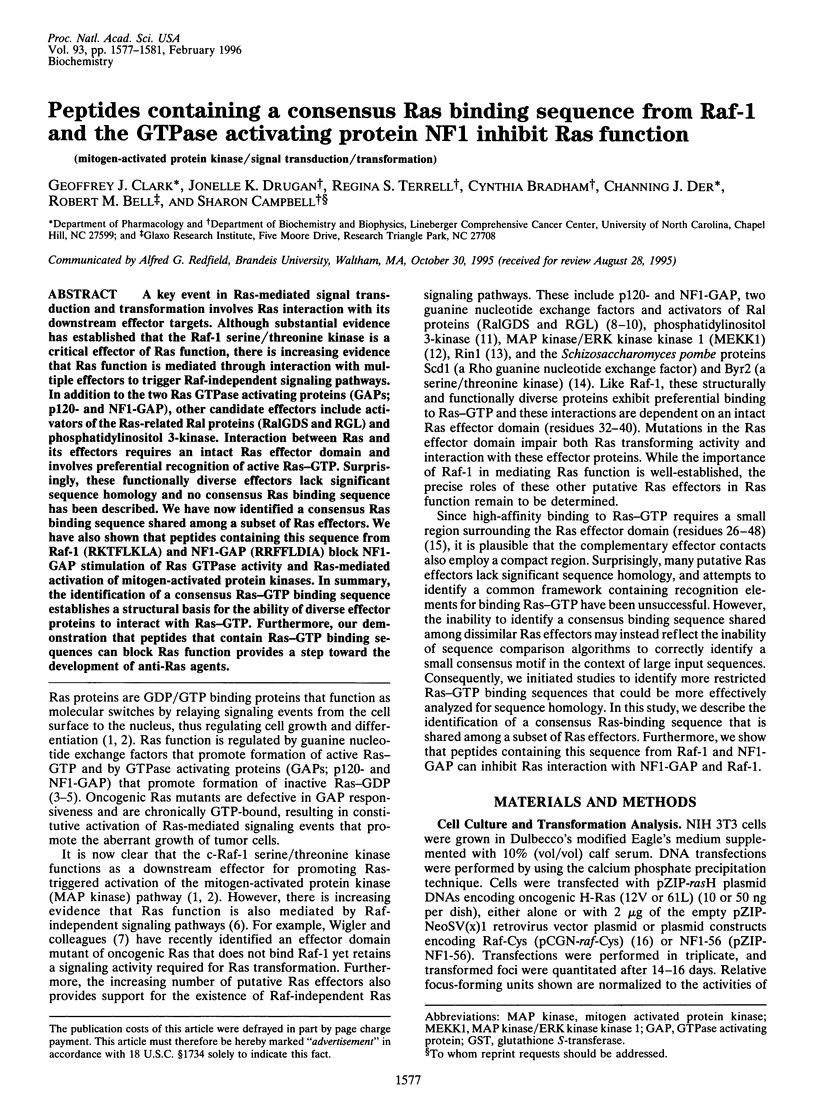
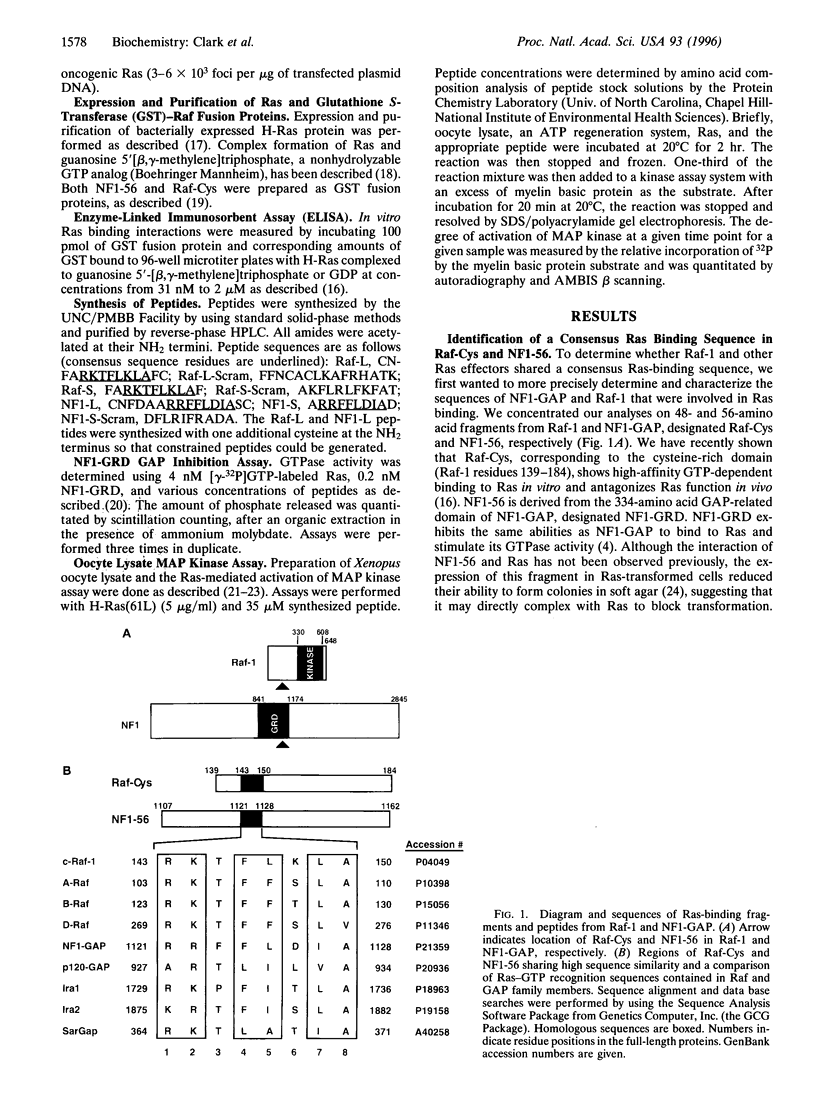
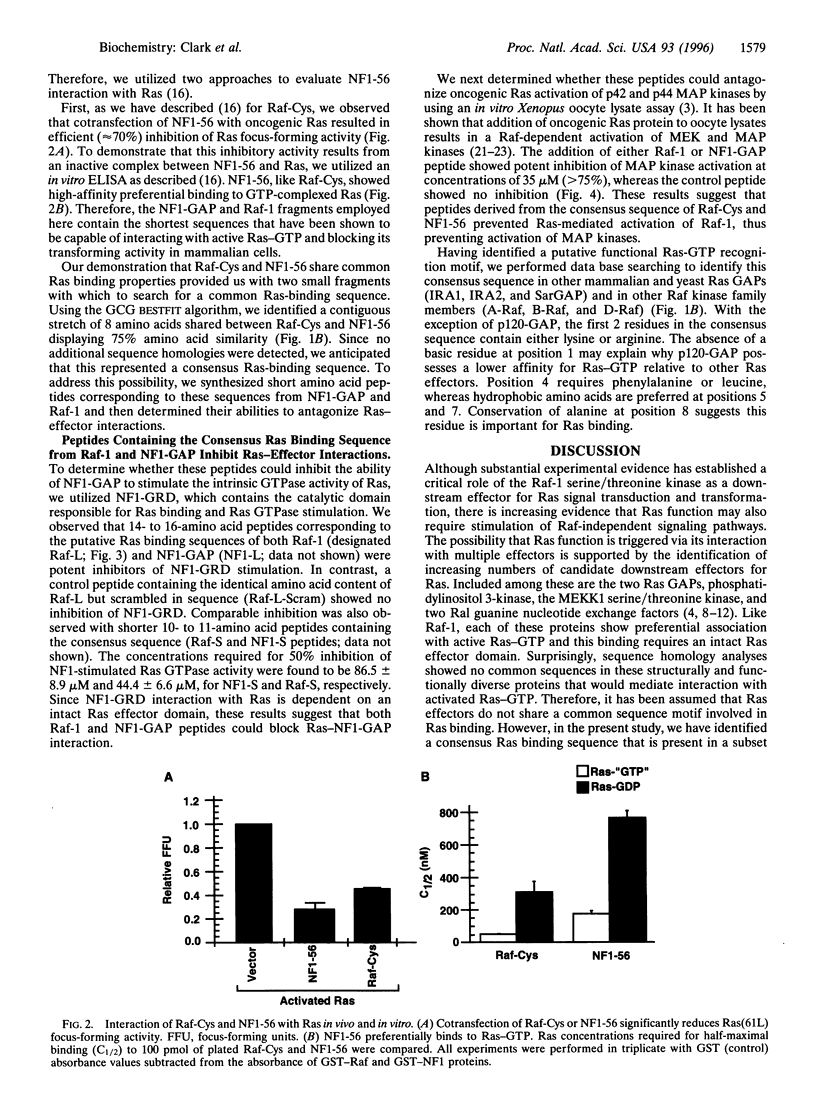
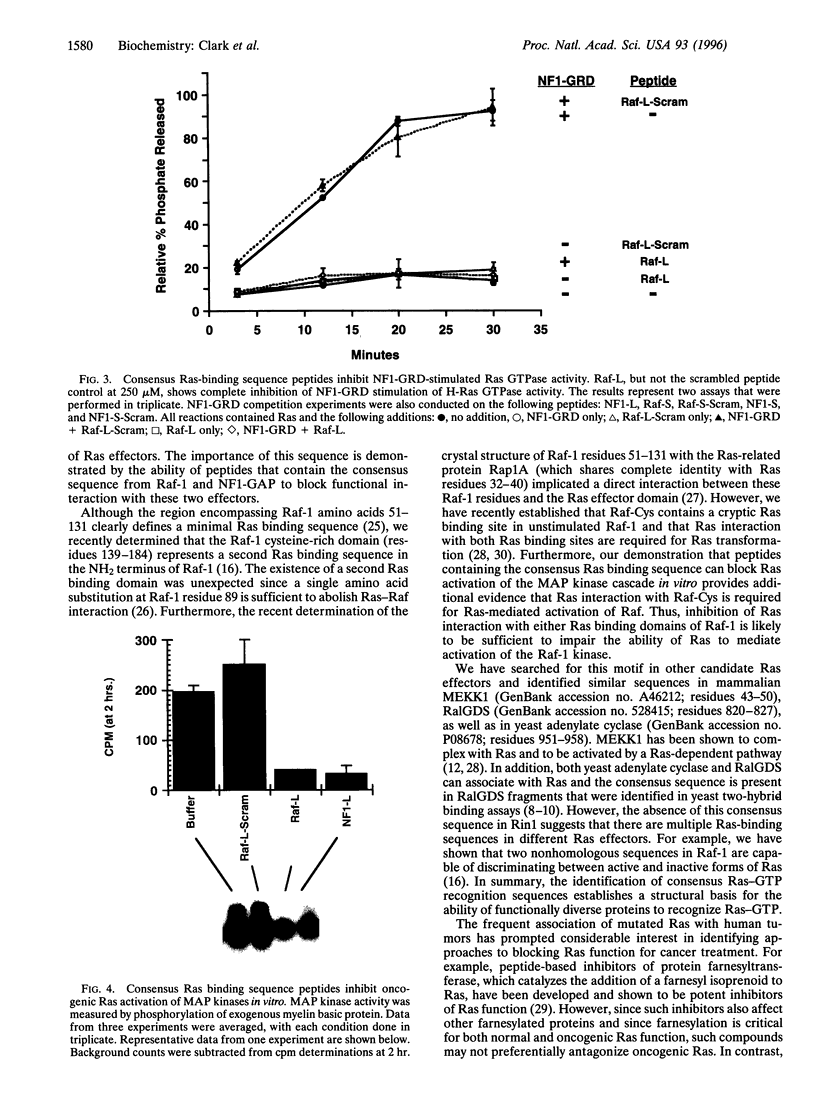
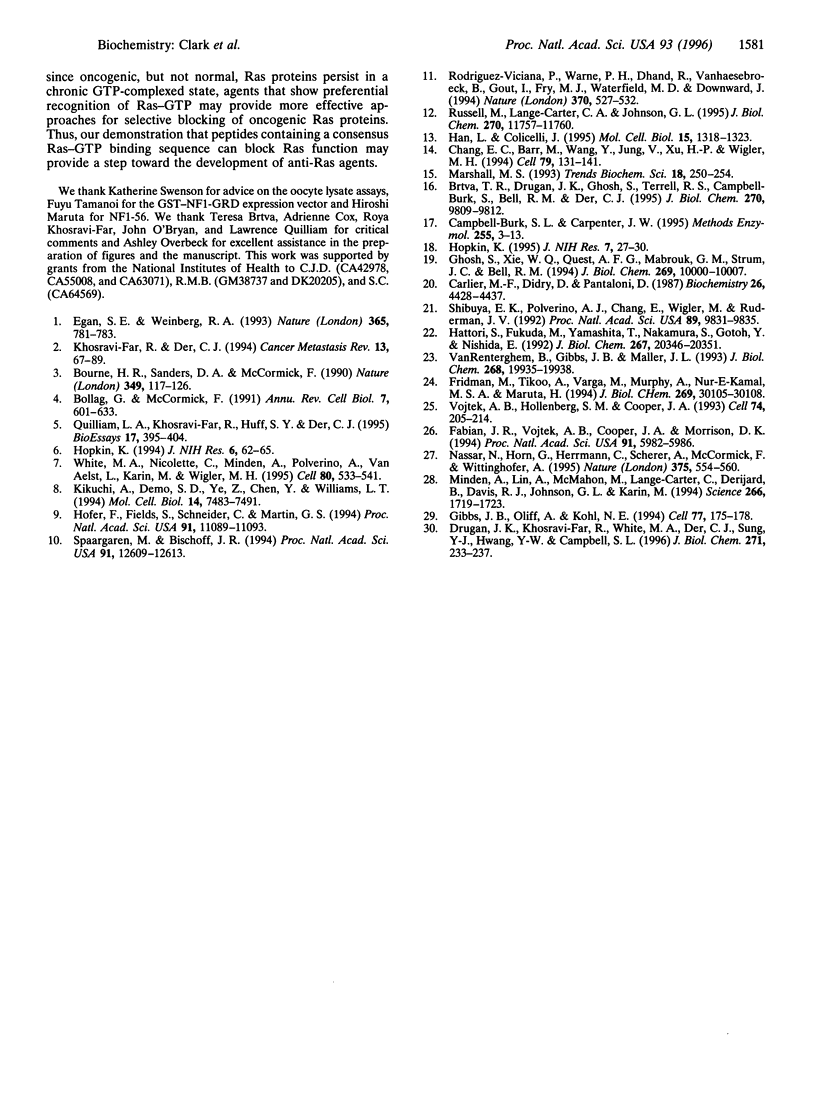
Images in this article
Selected References
These references are in PubMed. This may not be the complete list of references from this article.
- Bollag G., McCormick F. Regulators and effectors of ras proteins. Annu Rev Cell Biol. 1991;7:601–632. doi: 10.1146/annurev.cb.07.110191.003125. [DOI] [PubMed] [Google Scholar]
- Bourne H. R., Sanders D. A., McCormick F. The GTPase superfamily: conserved structure and molecular mechanism. Nature. 1991 Jan 10;349(6305):117–127. doi: 10.1038/349117a0. [DOI] [PubMed] [Google Scholar]
- Brtva T. R., Drugan J. K., Ghosh S., Terrell R. S., Campbell-Burk S., Bell R. M., Der C. J. Two distinct Raf domains mediate interaction with Ras. J Biol Chem. 1995 Apr 28;270(17):9809–9812. doi: 10.1074/jbc.270.17.9809. [DOI] [PubMed] [Google Scholar]
- Campbell-Burk S. L., Carpenter J. W. Refolding and purification of Ras proteins. Methods Enzymol. 1995;255:3–13. doi: 10.1016/s0076-6879(95)55003-8. [DOI] [PubMed] [Google Scholar]
- Carlier M. F., Didry D., Pantaloni D. Microtubule elongation and guanosine 5'-triphosphate hydrolysis. Role of guanine nucleotides in microtubule dynamics. Biochemistry. 1987 Jul 14;26(14):4428–4437. doi: 10.1021/bi00388a036. [DOI] [PubMed] [Google Scholar]
- Chang E. C., Barr M., Wang Y., Jung V., Xu H. P., Wigler M. H. Cooperative interaction of S. pombe proteins required for mating and morphogenesis. Cell. 1994 Oct 7;79(1):131–141. doi: 10.1016/0092-8674(94)90406-5. [DOI] [PubMed] [Google Scholar]
- Drugan J. K., Khosravi-Far R., White M. A., Der C. J., Sung Y. J., Hwang Y. W., Campbell S. L. Ras interaction with two distinct binding domains in Raf-1 may be required for Ras transformation. J Biol Chem. 1996 Jan 5;271(1):233–237. doi: 10.1074/jbc.271.1.233. [DOI] [PubMed] [Google Scholar]
- Egan S. E., Weinberg R. A. The pathway to signal achievement. Nature. 1993 Oct 28;365(6449):781–783. doi: 10.1038/365781a0. [DOI] [PubMed] [Google Scholar]
- Fabian J. R., Vojtek A. B., Cooper J. A., Morrison D. K. A single amino acid change in Raf-1 inhibits Ras binding and alters Raf-1 function. Proc Natl Acad Sci U S A. 1994 Jun 21;91(13):5982–5986. doi: 10.1073/pnas.91.13.5982. [DOI] [PMC free article] [PubMed] [Google Scholar]
- Fridman M., Tikoo A., Varga M., Murphy A., Nur-E-Kamal M. S., Maruta H. The minimal fragments of c-Raf-1 and NF1 that can suppress v-Ha-Ras-induced malignant phenotype. J Biol Chem. 1994 Dec 2;269(48):30105–30108. [PubMed] [Google Scholar]
- Ghosh S., Xie W. Q., Quest A. F., Mabrouk G. M., Strum J. C., Bell R. M. The cysteine-rich region of raf-1 kinase contains zinc, translocates to liposomes, and is adjacent to a segment that binds GTP-ras. J Biol Chem. 1994 Apr 1;269(13):10000–10007. [PubMed] [Google Scholar]
- Gibbs J. B., Oliff A., Kohl N. E. Farnesyltransferase inhibitors: Ras research yields a potential cancer therapeutic. Cell. 1994 Apr 22;77(2):175–178. doi: 10.1016/0092-8674(94)90308-5. [DOI] [PubMed] [Google Scholar]
- Han L., Colicelli J. A human protein selected for interference with Ras function interacts directly with Ras and competes with Raf1. Mol Cell Biol. 1995 Mar;15(3):1318–1323. doi: 10.1128/mcb.15.3.1318. [DOI] [PMC free article] [PubMed] [Google Scholar]
- Hattori S., Fukuda M., Yamashita T., Nakamura S., Gotoh Y., Nishida E. Activation of mitogen-activated protein kinase and its activator by ras in intact cells and in a cell-free system. J Biol Chem. 1992 Oct 5;267(28):20346–20351. [PubMed] [Google Scholar]
- Hofer F., Fields S., Schneider C., Martin G. S. Activated Ras interacts with the Ral guanine nucleotide dissociation stimulator. Proc Natl Acad Sci U S A. 1994 Nov 8;91(23):11089–11093. doi: 10.1073/pnas.91.23.11089. [DOI] [PMC free article] [PubMed] [Google Scholar]
- Khosravi-Far R., Der C. J. The Ras signal transduction pathway. Cancer Metastasis Rev. 1994 Mar;13(1):67–89. doi: 10.1007/BF00690419. [DOI] [PubMed] [Google Scholar]
- Kikuchi A., Demo S. D., Ye Z. H., Chen Y. W., Williams L. T. ralGDS family members interact with the effector loop of ras p21. Mol Cell Biol. 1994 Nov;14(11):7483–7491. doi: 10.1128/mcb.14.11.7483. [DOI] [PMC free article] [PubMed] [Google Scholar]
- Marshall M. S. The effector interactions of p21ras. Trends Biochem Sci. 1993 Jul;18(7):250–254. doi: 10.1016/0968-0004(93)90175-m. [DOI] [PubMed] [Google Scholar]
- Minden A., Lin A., McMahon M., Lange-Carter C., Dérijard B., Davis R. J., Johnson G. L., Karin M. Differential activation of ERK and JNK mitogen-activated protein kinases by Raf-1 and MEKK. Science. 1994 Dec 9;266(5191):1719–1723. doi: 10.1126/science.7992057. [DOI] [PubMed] [Google Scholar]
- Nassar N., Horn G., Herrmann C., Scherer A., McCormick F., Wittinghofer A. The 2.2 A crystal structure of the Ras-binding domain of the serine/threonine kinase c-Raf1 in complex with Rap1A and a GTP analogue. Nature. 1995 Jun 15;375(6532):554–560. doi: 10.1038/375554a0. [DOI] [PubMed] [Google Scholar]
- Quilliam L. A., Khosravi-Far R., Huff S. Y., Der C. J. Guanine nucleotide exchange factors: activators of the Ras superfamily of proteins. Bioessays. 1995 May;17(5):395–404. doi: 10.1002/bies.950170507. [DOI] [PubMed] [Google Scholar]
- Rodriguez-Viciana P., Warne P. H., Dhand R., Vanhaesebroeck B., Gout I., Fry M. J., Waterfield M. D., Downward J. Phosphatidylinositol-3-OH kinase as a direct target of Ras. Nature. 1994 Aug 18;370(6490):527–532. doi: 10.1038/370527a0. [DOI] [PubMed] [Google Scholar]
- Russell M., Lange-Carter C. A., Johnson G. L. Direct interaction between Ras and the kinase domain of mitogen-activated protein kinase kinase kinase (MEKK1). J Biol Chem. 1995 May 19;270(20):11757–11760. doi: 10.1074/jbc.270.20.11757. [DOI] [PubMed] [Google Scholar]
- Shibuya E. K., Polverino A. J., Chang E., Wigler M., Ruderman J. V. Oncogenic ras triggers the activation of 42-kDa mitogen-activated protein kinase in extracts of quiescent Xenopus oocytes. Proc Natl Acad Sci U S A. 1992 Oct 15;89(20):9831–9835. doi: 10.1073/pnas.89.20.9831. [DOI] [PMC free article] [PubMed] [Google Scholar]
- Spaargaren M., Bischoff J. R. Identification of the guanine nucleotide dissociation stimulator for Ral as a putative effector molecule of R-ras, H-ras, K-ras, and Rap. Proc Natl Acad Sci U S A. 1994 Dec 20;91(26):12609–12613. doi: 10.1073/pnas.91.26.12609. [DOI] [PMC free article] [PubMed] [Google Scholar]
- VanRenterghem B., Gibbs J. B., Maller J. L. Reconstitution of p21ras-dependent and -independent mitogen-activated protein kinase activation in a cell-free system. J Biol Chem. 1993 Sep 25;268(27):19935–19938. [PubMed] [Google Scholar]
- Vojtek A. B., Hollenberg S. M., Cooper J. A. Mammalian Ras interacts directly with the serine/threonine kinase Raf. Cell. 1993 Jul 16;74(1):205–214. doi: 10.1016/0092-8674(93)90307-c. [DOI] [PubMed] [Google Scholar]
- White M. A., Nicolette C., Minden A., Polverino A., Van Aelst L., Karin M., Wigler M. H. Multiple Ras functions can contribute to mammalian cell transformation. Cell. 1995 Feb 24;80(4):533–541. doi: 10.1016/0092-8674(95)90507-3. [DOI] [PubMed] [Google Scholar]



